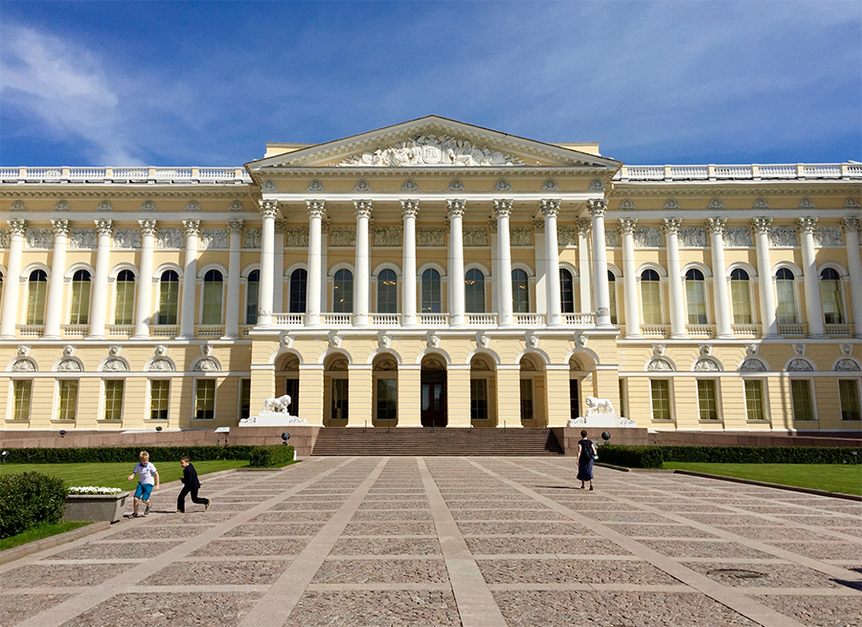The Mikhailovsky Palace, the main building of the Russian Museum. Formerly the imperial residence of Grand Duke Michael Pavlovich, it took six years to build and was completed in 1825. All photos by Sylvia Tsai for ArtAsiaPacific.
The Raising of Lazarus, The Old Testament Trinity, The Purification, St. John the Theologian and
Prochorus, c. 15th century.
Inside one of the grand rooms in the Mikhailovsky Palace.
KARL BRIULLOV, The Last Day of Pompeii, 1830–33. This work was originally displayed at the Imperial Academy of Arts as an example for young artists.
Inside the Benois Wing of the Russian Museum, which houses the institution’s 19th- and 20th-century art collection.
(Left) VLADIMIR TATLIN’s Counter Reliefs, 1914, iron, copper and wood; (right) KAZIMIR MALEVICH, The Sportsmen, 1928–32, oil on canvas. The two artists are considered avant-garde masters of Soviet-era art.
NATALIA GONCHAROVA, Picking Fruit, 1908, oil on canvas, polyptych. The artist’s portrayal of Russian rural life was a stark move away from styles of the French avant-garde, which she was heavily influenced by early on in her career. Goncharova’s work marked a transition in Russian art, focusing on discovering an identity by looking to its own people.
Suprematist-style porcelain created by NIKOLAI SUETIN, around 1920–30s, who was a frequent collaborator with KAZIMIR MALEVICH.
The Marble Palace, part of the Russian Museum.
Opening of the solo show of Iranian artist REZA DERAKSHANI at the Marble Palace.
REZA DERAKSHANI, Secret Love, 2016, enamel and glaze on canvas.
REZA DERAKSHANI, untitled work from 2015 that carries on his exploration of the huntsman figure from the Persian epic Shahnameh, one of the artist’s frequent motifs that is used to represent the morally good and uncorrupt.
One floor down in the Marble Palace was an exhibition of works from the late 20th century gifted to the Russian Museum by German collectors Peter and Irene Ludwig, which include pieces by Pablo Picasso, Andy Warhol, Jean-Michel Basquiat and Jasper Johns among others. (Left) ROY LICHTENSTEIN, Ruins, 1965, acrylic on canvas; (right) JEAN-MICHEL BASQUIAT and ANDY WARHOL, Untitled, 1984, oil and acrylic on canvas.
Exterior view of the Winter Palace, one of the buildings of the Hermitage. From 1732 to 1917, it served as the official residence of the Russian monarch before becoming a museum.
Joined to the main building of the Hermitage is the “New Hermitage,” the first building specially constructed from 1842 to 1851 to house the museum’s collection. The monumental Atlantes figures, supporting the portico, is made from gray granite.
Courtyard of the Hermitage.
Jordan Staircase of the Winter Palace, Hermitage.
Gold Room of the Winter Palace, Hermitage.
Military Gallery at the Winter Palace, Hermitage, where 332 portraits of generals who participated in the 1812 Patriotic War line the walls.
The Tent Room in the New Hermitage building is dedicated to Dutch paintings, including a 23-piece collection of works by Rembrandt. The Hermitage reopened this restored gallery in December 2014.
General Staff Building on Palace Square, originally constructed from 1819 to 1829, to house various government ministries. The eastern wing now displays the museum’s 19th- and 20th-century painting and sculpture collection and European and decorative art, while the west wing continues to be the headquarters of the Western Military District. The building’s conversion to the museum was completed in 2014, in time for its 250th anniversary.
Albert Kostenevich, Head of the Department of Impressionists at the Hermitage introducing French pastels of the 19th and 20th centuries.
CLAUDE MONET, Woman in a Garden, 1876, oil on canvas.
Detail of the meticulously painted colors of pointillist PAUL SIGNAC’s oil on canvas Port of Marseilles, 1906–07.
VINCENT VAN GOGH, Landscape with House and Ploughman, 1889, oil on canvas.
MAURICE DENIS, The Story of Psyche. Fourth Panel: The Vengeance of Venus: Psyche, Opening the Box of Dreams of the Underworld_, Sinks into Sleep, 1908, oil on canvas.
PIERRE BONNARD, On the Mediterranean, triptych, 1911, oil on canvas. The work was originally a commission by Russian collector Ivan Morozov. Bonnard, a French painter, created a triptych to fit between columns of Morozov’s staircase at home—without ever traveling to Russia. The Hermitage received the work in 1948 and re-created the original setting of the collector’s residence.
PABLO PICASSO, (left) Dance with Veils, 1907, and (right) Friendship, 1908.
In the Picasso wing of the Hermitage within the General Staff Building, showcasing works from his “Blue” period.
Albert Kostenevich, Head of the Department of Impressionists at the Hermitage in front of PABLO PICASSO’s Trois Femmes, 1908.
Dedicated gallery to the paintings of HENRI MATISSE.
Dedicated gallery to the paintings of HENRI MATISSE.
HENRI MATISSE, Family Portrait, 1911, oil on canvas.




